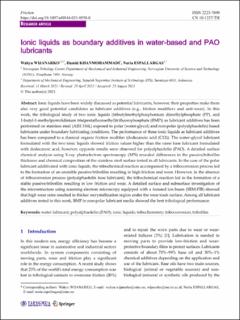| dc.contributor.author | Wijanarko, Wahyu | |
| dc.contributor.author | Khanmohammadi, Hamid | |
| dc.contributor.author | Espallargas, Nuria | |
| dc.date.accessioned | 2022-03-04T12:15:33Z | |
| dc.date.available | 2022-03-04T12:15:33Z | |
| dc.date.created | 2021-12-20T15:17:46Z | |
| dc.date.issued | 2021 | |
| dc.identifier.citation | Friction. 2021, . | en_US |
| dc.identifier.issn | 2223-7690 | |
| dc.identifier.uri | https://hdl.handle.net/11250/2983152 | |
| dc.description.abstract | Ionic liquids have been widely discussed as potential lubricants, however, their properties make them also very good potential candidates as lubricant additives (e.g., friction modifiers and anti-wear). In this work, the tribological study of two ionic liquids (tributylmethylphosphonium dimethylphosphate (PP), and 1-butyl-1-methylpyrrolidinium tris(pentafluoroethyl)trifluorophosphate (BMP)) as lubricant additives has been performed on stainless steel (AISI 316L) exposed to polar (water-glycol) and non-polar (polyalphaolefin) based lubricants under boundary lubricating conditions. The performance of these ionic liquids as lubricant additives has been compared to a classical organic friction modifier (dodecanoic acid (C12)). The water-glycol lubricant formulated with the two ionic liquids showed friction values higher than the same base lubricant formulated with dodecanoic acid, however, opposite results were observed for polyalphaolefin (PAO). A detailed surface chemical analysis using X-ray photoelectron spectroscopy (XPS) revealed differences in the passive/tribofilm thickness and chemical composition of the stainless steel surface tested in all lubricants. In the case of the polar lubricant additivated with ionic liquids, the tribochemical reaction accompanied by a tribocorrosion process led to the formation of an unstable passive/tribofilm resulting in high friction and wear. However, in the absence of tribocorrosion process (polyalphaolefin base lubricant), the tribochemical reaction led to the formation of a stable passive/tribofilm resulting in low friction and wear. A detailed surface and subsurface investigation of the microstructure using scanning electron microscopy equipped with a focused ion beam (SEM-FIB) showed that high wear rates resulted in thicker recrystallization region under the wear track surface. Among all lubricant additives tested in this work, BMP in non-polar lubricant media showed the best tribological performance. | en_US |
| dc.language.iso | eng | en_US |
| dc.publisher | Springer | en_US |
| dc.rights | Navngivelse 4.0 Internasjonal | * |
| dc.rights.uri | http://creativecommons.org/licenses/by/4.0/deed.no | * |
| dc.title | Ionic liquids as boundary additives in water-based and PAO lubricants | en_US |
| dc.type | Peer reviewed | en_US |
| dc.type | Journal article | en_US |
| dc.description.version | publishedVersion | en_US |
| dc.source.pagenumber | 19 | en_US |
| dc.source.journal | Friction | en_US |
| dc.identifier.doi | 10.1007/s40544-021-0550-0 | |
| dc.identifier.cristin | 1970646 | |
| dc.relation.project | Norges forskningsråd: 272845 | en_US |
| dc.relation.project | Norges forskningsråd: 295864 | en_US |
| cristin.ispublished | true | |
| cristin.fulltext | original | |
| cristin.qualitycode | 1 | |

